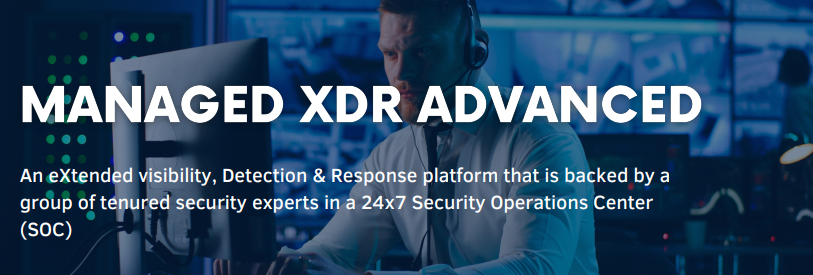Day by day new forms of cyber threats emerge and become increasingly complex. The days of single vector, simple attacks are gone. Attacks are evolving into multi-vector, layered operations - which must be countered with a multi-vector, layered defense.
According to Barracuda’s XDR round-up 2023, “High-severity detections during 2023 included 66,000 threats serious enough to be escalated to a SOC analyst for investigation, and a further 15,000 that required urgent and immediate defensive action. There was a steady rise in both threat categories throughout the year — peaking from October into November and December.”
XDR Defined
XDR is an acronym used for (e)Xtended Detection Response, and in a nutshell, it is a comprehensive tool used to view threats across different vectors. The XDR has evolved from the EDR, or endpoint detection response. Endpoint detection response is solely focused on detecting threats on endpoints. While securing the endpoints is crucial, with the increasing complexity of attacks, it is no longer adequate.
Proactivity is the name of the game when it comes to the XDR. Once an attack occurs, it is often too late to respond, so it is imperative to identify attacks before they wreak havoc.
Barracuda XDR Features
One prime example of a top-tier XDR solution can be found in Barracuda’s XDR platform. By seamlessly integrating AI-based account profiling, comprehensive event collection and analysis, and the detection of common high-risk threats, Barracuda’s XDR stands out in identifying and thwarting potential security risks.
This sophisticated tool not only provides a holistic view of threats across various vectors but also offers proactive measures to safeguard against evolving cyber threats. With a focus on leveraging advanced technology and expert insights, Barracuda’s XDR sets a high standard in the realm of cybersecurity defense.
To learn more about Barracuda’s XDR service, feel free to follow this link.
Account Profiling
Taking a deeper dive into each aspect, let’s look first at the AI-based account profiling feature. Using AI, the XDR will study each user’s common login patterns - which includes frequent login times, tone of messaging, commonly used apps, as well as most frequent locations that logins occur.
When events that deviate from the norm occur, the XDR will flag them. For example, take a company based in California that sees a login attempt from India - a place where there is no office, or employees located. The XDR will flag this log-in attempt and deny the entry even when the credentials were possibly correct.
In addition to unusual locations, the XDR also can flag when users log in at unusual times. For example, a user that works the traditional 9-5 work schedule having a login attempt at 1 am is going to flag and be denied. These instances are examples of “high-risk” incidents, which will be detected and remediated by the XDR.

Event Collection & Analysis
In regard to the event collection and analysis feature, it collects virtually every IT event from integrated network, cloud, email, endpoint, and server security tools. Among these events includes login attempts, network connections, email messages, file activities, configuration changes, and security warnings. By having a database of every event, the XDR is able to identify trends and recognize deviations from these trends.
The most important feature of the XDR in comparison to other security measures, is the ability to effectively identify and counter multi vectored attacks. Having holistic data integration is the biggest key to achieving this level of security. Data is integrated from email, endpoints, servers, cloud workloads, and networks. Having this consolidated, unified organization of data allows for threats that are across multiple vectors to be quickly identified and remediated.
Advanced Persistent Threats
In addition, the XDR is very effective in countering advanced persistent threats (APT), which are sophisticated and stealthy cyberattacks that aim to gain prolonged access to an organization’s systems for data theft, espionage, or disruption. Having access to data across multiple platforms allows for the detection of these stealthy attacks, and the subsequent remediation.
The XDR is highly effective in identifying threats, and also is very effective in remediating threats that are detected. The XDR has a variety of methods to remediate potential threats.
For endpoints, this includes:
-
Collect investigation package.
-
Isolate the device (this action can be undone).
-
Offboard the machine.
-
Release code execution.
-
Release from quarantine.
-
Request a sample.
-
Restrict code execution (this action can be undone).
-
Run an antivirus scan, stop and quarantine.
-
Contain devices from the network.
XDR can also take actions on accounts - disabling compromised users, changing passwords, and confirming a user as compromised.
XDR will perform a majority of these features automatically, but ones with more significant implications will be pending approval in the action center feature. This feature is accessible to the organization’s global admin.
How Datalink Can Help with your XDR Needs
The XDR is the best tool to provide a holistic approach to cybersecurity, and counter the new wave of complex attacks. Between the identification of trends and integration of data across platforms, XDR keeps your organization safe.
Datalink Networks offers an advanced XDR service through our partner, Barracuda Networks. This XDR combines AI analysis features with an expert security team within the Security Operations Center (SOC) to provide the highest quality comprehensive security for your organization. It’s no secret just how detrimental cyber-attacks can be, and it is imperative to prevent them before they occur.
Check out the flyer below for our XDR Advanced service!






